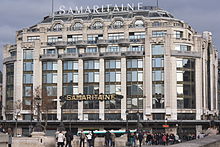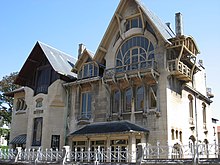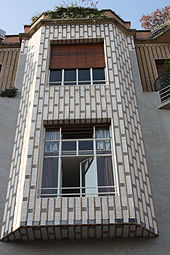Henri Sauvage

Henri Sauvage (also Frédéric-Henri Sauvage) (born May 10, 1873 in Rouen , † March 21, 1932 in Paris ) was a French architect whose buildings reflect the development from Art Nouveau to Art Deco . He designed villas and hotels as well as furniture and interiors for private homes and businesses. With Frantz Jourdain (1847–1935), Henri Sauvage carried out the extension of the Parisian department store La Samaritaine . In Paris and Le Havre he built rental apartments in reinforced concrete . He advocated the use of prefabricated components and experimented with new materials.
family
Henri Sauvage came from a family of industrialists from Rouen. His grandfather ran a spinning mill . His father, Henri-Albert Sauvage, was a lawyer at the Rouen court and settled in Paris in 1890, where he founded the Jolly et Sauvage wallpaper and fabric factory with Alexandre-Amédée Jolly . Henri Sauvage was married to Marie-Louise Charpentier, daughter of the sculptor Alexandre Charpentier . With her he had a son and three daughters.
career
In 1890, Henri Sauvage was accepted into the École des Beaux-Arts in Paris. There he attended the courses of Jean-Louis Pascal. In 1895 he finished his training, although he had received several awards, without a degree.
For his father's company, Jolly et Sauvage, he set up an interior decorating shop on Rue de Rohan in the 1st arrondissement of Paris, which no longer existed, and one of his customers was Hector Guimard . Henri Sauvage also designed Art Nouveau furniture based on the model of Gustave Serrurier-Bovy . In the workshop of the sculptor Alexandre Charpentier, whose daughter he married in 1898, Henri Sauvage met the cabinet maker Louis Majorelle (1859–1926), the painters Henri Toulouse-Lautrec and Auguste Renoir .
Henri Sauvage received an order from Louis Majorelle in 1898 to build a villa ( Villa Majorelle ) in Nancy , which was completed in 1902 and made the young architect famous. The construction of the theater for Loïe Fuller, which had been demolished again for the Paris World Exhibition of 1900, also made it famous.
Around 1900, Henri Sauvage teamed up with the architect Charles Sarazin, who was involved in almost all of his buildings until 1916. Together with him he worked for the Société Anonyme des Logements Hygiéniques à Bon Marché (Society for hygienic and inexpensive apartments) founded in 1903 by Frantz Jourdain, Paul Gallimard, Amédée Dherbécourt , whose first project was the apartment building on Rue Trétaigne in the 18th arrondissement of Paris was. Innovations were the construction in reinforced concrete with brick as the filling material, the bay windows and the prefabricated wall boxes made of exposed concrete protruding under the kitchen windows, which served as natural refrigerators. The concrete facade of the tenement building on Boulevard de l'Hôpital No. 165 in the 13th arrondissement of Paris, built by the same company, was completely clad with ceramic tiles.
In an effort to build apartments that were supplied with plenty of light and air, Henri Sauvage developed the step houses. His first stepped building, the facade of which was also clad with ceramic tiles, was completed in 1913. It was in this house at 26 rue Vavin in the 6th arrondissement of Paris that Henri Sauvage set up his office from 1913 until his death in 1932.
In 1916 he received an order from the Société Anonyme des Logements Hygiéniques à Bon Marché for a tenement house in the Rue des Amiraux in the 18th arrondissement of Paris, which he also built in stages. A swimming pool was installed in the lower middle area, which was otherwise difficult to use.
In 1923 Henri Sauvage founded the Société des architectes modern (Society of Modern Architects) with Frantz Jourdain, Hector Guimard, Joachim Richard, Pierre Sézille, Louis Brachet and Tony Selmersheim and in 1926 he founded the Société de Construction Rapide (Society for rapid construction) with the aim to advance the standardization and commercialization of precast parts. He also experimented with new materials such as Solomit (coated construction panels made of straw) and fiber cement .
Buildings
- 1898–1902: Villa Majorelle, Rue Louis-Majorelle No. 1 in Nancy , with the architect Lucien Weissenburger , Alexandre Charpentier (sculptor), Francis Jourdain (interior design), Alexandre Bigot (ceramicist).
- 1899: Two rooms are set up in the Café de Paris at 41 avenue de l'Opéra in the 1st arrondissement of Paris. The furnishings were destroyed in the 1950s and the salon mauve was reconstructed in the Musée Carnavalet in Paris.
- 1903: Tenement at 17 rue Damrémont in the 18th arrondissement of Paris
- 1903–1904: Tenement at 7 rue de Trétaigne in the 18th arrondissement of Paris
- 1904: Tenement at 22 rue Laugier in the 17th arrondissement of Paris
- 1905: Tenement at 10 rue Danville in the 14th arrondissement of Paris
- 1905–1906: Tenement at 20 rue Sévero in the 14th arrondissement of Paris
- 1906: Hôtel Princess (former Hôtel des Voyageurs), Boulevard Sainte-Beuve No. 4-6 in Boulogne-sur-Mer
- 1906: Villa Marcot (annex to the Jacques Monod College) at 16 avenue Thiers in Compiègne
- 1907: Villa Natacha at 110 rue d'Espagne in Biarritz
- 1907: Tenement and shopping mall, Cité de l'Argentine, 111 avenue Victor-Hugo in the 16th arrondissement of Paris
- 1907: Tenement at No. 1 rue de la Chine in the 20th arrondissement of Paris
- 1908–1909: Tenement at 165 Boulevard de l'Hôpital in the 13th arrondissement of Paris
- Around 1909: Hôtel Trianon Les Terrasses in Le Tréport in the Seine-Maritime department
- 1909–1912: Gran Hotel Ancira (formerly Palace Hotel), Avenue Melchor Ocampo Oriente No. 443 in Monterrey (Mexico)
- 1911: Tenement at 29 rue de la Boétie in the 8th arrondissement of Paris
- 1911: Tenement at 26 rue Jean Macé in Le Havre
- 1912–1913: Stepped house at 26–28 Rue Vavin in the 6th arrondissement of Paris
- 1913: Commercial and office building for Majorelle & Cie, 126 Rue de Provence in the 9th arrondissement of Paris
- 1916–1927: Stepped apartment building with swimming pool, 13 rue des Amiraux in the 18th arrondissement of Paris
- Around 1919: Residence of the director of the SECB in Mimizan in the Landes department
- 1920: Gambetta Palace cinema , 6 rue Belgrand in the 20th arrondissement of Paris
- 1922: Residential building at 137 Boulevard Raspail in the 6th arrondissement of Paris
- 1923–1924: House at 14–16 Boulevard Raspail in the 6th arrondissement of Paris
- 1923–1925: House at 6 avenue Sully – Prudhomme in the 7th arrondissement of Paris, with the sculptor François Pompon
- 1923–1926: House at 22–24 rue Beaujon in the 8th arrondissement of Paris
- 1924: Apartment building at 50 avenue Duquesne in the 7th arrondissement of Paris
- 1924–1925: House at 42 rue de la Pompe in the 16th arrondissement of Paris
- 1925: Villa in Combs-la-Ville in the Seine-et-Marne department
- 1926: Residential house at 19 Boulevard Raspail in the 7th arrondissement of Paris
- 1926: Villa for the Henri Sauvage family in Saint-Martin-la-Garenne in the Yvelines department , with Raymond Subes and François Pompon
- 1926: School and Town Hall, Place Communale nos. 30–40 in Étreux in the Aisne department
- 1926: Garage on Rue Campagne-Première in the 14th arrondissement of Paris
- 1926–1927: Apartment building and artist studios , Studio Building , 65 rue La Fontaine , 2-4 rue du Général Largeau, 21–35 rue des Perchamps in the 16th arrondissement of Paris
- 1926–1928: Extension of the La Samaritaine department store , Rue du Pont Neuf / Quai du Louvre in the 1st arrondissement of Paris, in collaboration with Frantz Jourdain
- 1927–1930: Office building at 8 rue Saint-Marc in the 2nd arrondissement of Paris
- 1927: "Le Sphinx" private club, 31 Boulevard Edgar-Quinet in the 14th arrondissement of Paris
- 1927: Villa for Maurice Bunau-Varilla, Rue de Chevreuse No. 12 in Orsay in the Essonne department , in collaboration with the architect Louis-Marie Charpentier
- 1928: Tenement at 27 rue Legendre in the 17th arrondissement of Paris
- 1928: Tenement at 8 bis Boulevard Maillot in Neuilly sur Seine
- 1928–1931: Residence, Square Gabriel-Fauré No. 4 in the 17th arrondissement of Paris, in collaboration with the architect Louis-Marie Charpentier
- 1929–1932: "Le Vert Galant" apartment building, Quai des Orfèvres No. 42 in the 1st arrondissement of Paris, in collaboration with the architect Louis-Marie Charpentier
- 1931: Hôtel particulier, Villa Madrid No. 11 in Neuilly-sur-Seine in the Hauts-de-Seine department
- 193: Decré department store, Rue du Moulin in Nantes , in collaboration with architects Louis-Marie Charpentier and L. D'Escrivan
literature
- Jean Colson, Marie-Christine Lauroa (ed.): Dictionnaire des Monuments de Paris . Éditions Hervas, Paris 2003 (1st edition 1992), ISBN 2-84334-001-2 .
- Franco Borsi, Ezio Godoli: Parisian buildings at the turn of the century. Architecture and design of the French metropolis around 1900 . Nikol Verlagsgesellschaft, Hamburg (no year), ISBN 3-930656-65-5 .
Web links
- Henri Sauvage in the Base Mérimée of the French Ministry of Culture (French)
- Henri Sauvage ( Memento of February 10, 2005 in the Internet Archive ) ARCHIGUIDE (French)
- Henri Sauvage Institut français d'architecture (French)
| personal data | |
|---|---|
| SURNAME | Sauvage, Henri |
| ALTERNATIVE NAMES | Sauvage, Frédéric-Henri |
| BRIEF DESCRIPTION | French architect |
| DATE OF BIRTH | May 10, 1873 |
| PLACE OF BIRTH | Rouen |
| DATE OF DEATH | March 21, 1932 |
| Place of death | Paris |





